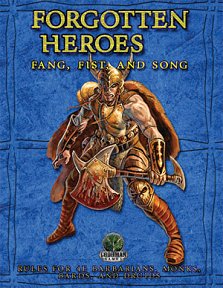
The Introduction states the purposes of this book: to introduce the concept of cataclysmic change in a game world and to present 4e versions of the barbarian, bard, druid and monk... which are linked to the apocalypic theme by being either manifestations of the new and changed world, or lingering remnants of an old order; although it is not of course necessary to have a world-shaking event just so that they may appear, you can just make the classes available if you prefer. Note that since this book was published, Wizards of the Coast produced the Player's Handbook 2 in which their versions of the barbarian, bard and druid appear. So, for those classes you have a choice of two variants.
Chapter 1 looks at The Apocalypse, and why you might want to have one in your campaign setting. There's an established history of the use of cataclysmic events in both fantasy fiction and within role-playing itself, whether it is just that things from the past are lost in the mists of time so odd and inexplicable ancient stuff can turn up and nobody knows how it works, or more directly a massive world-shaking war or natural disaster has wreaked such havoc that the established order is no more. There is clearly a lot of potential there for adventure... but first you have to decide how long ago the apocalyptic event took place - or even if it is still in progress. Another decision is what caused it to happen, which will determine both the state of affairs now and influence the sort of adventures that might occur as a direct result of the cataclysm and its aftermath. Some examples from fiction and film are included, with reasons for why that particular event might work well in your campaign.
Next, Chapter 2 discusses Conflicts. Now, there's always a lot of combat within a role-playing game, but the discussion here concentrates on why what has happened might be a reason for friction - almost inevitably leading to violence - between different groups of people. Even if you are not planning a major catastrophe in your campaign world, this might give you some ideas for why different groups can be working towards different ends, ones so different that the result is conflict, often spilling out beyond the original groups to involve other people. In keeping with the parallel purpose of this book to bring in new character classes, most of the conflict points involve different organisations or groupings such as bardic colleges and barbarian tribes. Having a background overarching conflict or quarrel can be a powerful tool for introducing an external influence on the characters: the barbarian, for example, might feel obliged to act because of what is or has happened to his tribe even if he isn't being threatened right now, or a druid might be attacked because of what other druids did in the past. Each class also holds potential for conflict between members of that class, particularly when there are limited leadership positions to contend for or a difference of opinion about how a certain situation should be dealt with.
This completes the coverage of the use of apocalypse in a campaign and is quite thought-provoking, although there is evidence of rather hasty work particularly in layout. The book then moves on to discuss the four classes in question, following a similar presentation style to the Player's Handbook. First up, the barbarian. He's pretty much what you'd expect, with a nice system of animal totems which confer appropriate benefits and powers depending on the totem chosen. The bard comes next, with 2 builds based on leadership either by flamboyant fighting or inspiration through word and music. Interestingly, your choice of instrument confers benefits according to what you play; and your choice of instrument can affect some of your powers (called 'performances') as well. Druids concentrate on the environmental or elemental aspects of the natural world and naturally they have animal companions. Of course, now the 'official' versions of these classes have been published, some people will want to discard these, but of course you may prefer these versions (to my mind this bard is closer to what I imagine than the Wizards one!). Alternatively, you can raid these for powers which you wish to make available to members of the class in question. You might also choose to use these classes to create NPCs, representing followers of different traditions to the 'mainstream' and so generate an area of conflict!
At the time of writing this review, no 'official' monk character class has been published. Monks are strikers, masters of melee especially without weapons, and can base their combat moves on either 'kick-boxing' or 'grappling' - striking or wrestling with opponents as preferred. Within this each monk also will have a particular fighting style which further characterises the way in which he fights.
The book winds up with a selection of feats, some mainly appropriate to members of the classes discussed here and others available to any character. There are also some class-appropriate magical items, especially musical instruments for bards, also druidic fetishes.
Overall this is a quite interesting work, although some may find it has been rendered redundant while others will mine it for additional powers and abilities for their characters. The discussion of the role of apocalypse is interesting and well worth a read, although it would probably be worth developing into a whole book of its own.
Return to Forgotten Heroes: Fang, Fist, and Song page.
Reviewed: 26 July 2009

